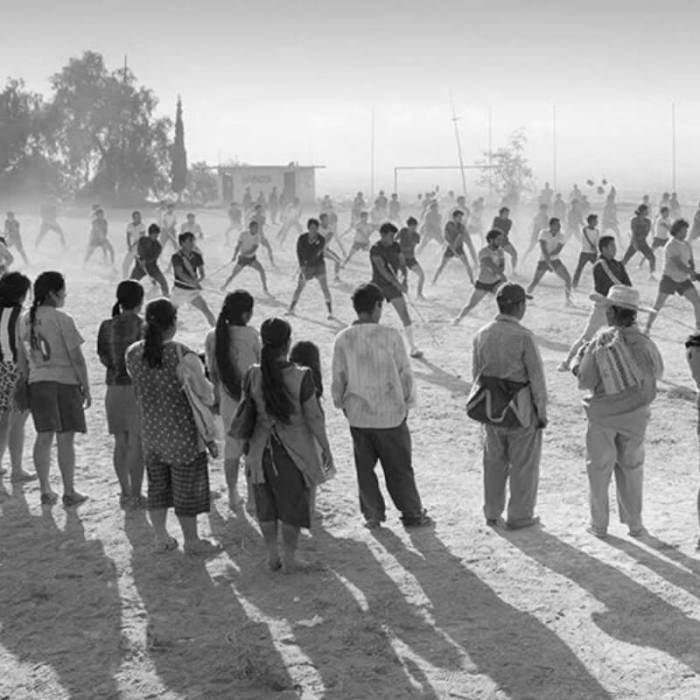Mexican director Alfonso Cuaron’s film “Roma” is one of the most talked-about movie events of the year. Have you seen it? Here are some interesting tidbits you should know.
Follow my blog and fall in love with Mexico!

Click to tweet this post
The film “Roma” is probably one of the biggest movie events of the year. To be honest, I find it quite surprising that it’s getting all this media attention.
Don’t get me wrong, the film certainly deserves it, but one has to admit it’s extremely rare to see an artsy, black-and-white, foreign-language film make it big in Hollywood.
In Mexico, “Roma” was greeted with mixed responses. Cuarón’s reputation as a director is outstanding, but not everybody went crazy for his personal, semi autobiographical work. I suppose sometimes you just can’t be a prophet in your own land.
In fact, there is a huge debate going on in Mexico about how you absolutely HAVE TO be from Mexico City to understand the film at all. Although I don’t agree with this stance, I do think you’ll understand the film better if you were born and raised in Mexico at least. But fear not! My job is to explain exactly what you need to know.
So anyway, what is all the positive and negative buzz about? Spoilers ahead!!
Interesting Tidbits about Alfonso Cuarón’s “Roma”
“Roma” is named after the Mexico City neighborhood where Cuarón grew up. “Colonia Roma” was for decades home to many of the city’s middle and upper-middle class families. With stately homes and tree-lined streets, Roma was a traditional, classy place to live in.
Nowadays, Roma is probably Mexico City’s most gentrified neighborhood, full of hipsters and wealthy, young up-and-comers. Few of the old, traditional middle class families remain. They probably can’t afford to live there anymore.
But Cuaron’s film brings back vividly the memories of the old Roma neighborhood everybody in Mexico City used to know and love. Nostalgia sets in from the first minute and continues until the end. It’s part of the heartbreak for Mexican audiences.

“Roma” is the curious portrait of a middle-class family and the loyal, devoted indigenous woman who works for them.
It’s also a semi-autobiographical film. Cuarón has been outspoken about it being inspired by the indigenous woman who worked for his family when he was growing up, and he even dedicates the movie to her.
Although this was a relatively common situation in Mexico in the past, it’s rarely seen today. Most middle-class families can’t afford a live-in maid, much less two, and housekeepers are usually very specific about not wanting to take care of someone else’s children.
Sadly, it’s still true that most housekeeping jobs are held by indigenous women. These women usually have little education and no access to social security and are subjected to harassment or abuse. Fortunately, it should be noted that this is not the case in “Roma”.
Perhaps the movie’s success could prompt a conversation about the way these women are treated.

One of the reasons “Roma” was highly criticized in Mexico, is how it portrays the main character, Cleo. Cleo is the family’s live-in maid and an indigenous woman who chats in her native tongue with the family’s other maid.
In Mexico, the portrayal of indigenous people in any kind of media has always been a sort of minefield. Sometimes the portrayal is too weak, or too distorted, or too imprecise, or just downright offensive. It’s nearly impossible to get this right.
Cuarón certainly did a better job than the Mexican moviemakers of decades past, who didn’t even cast indigenous people in ethnic roles. His choice of Yalitzia Aparicio, a woman of ethnic mixtec descent, is outstanding in this case. It’s also noticeable that he decided to include dialogues in Aparicio’s own native mixtec tongue.
However, the character probably falls into the typical Mexican portrayal of the loyal and devoted indigenous servant. This was a major source of controversy in Mexico, but let’s keep in mind this is a very personal film. Cuarón is probably just recreating the stoic stance, as he saw it, of the housekeeper nanny he grew to admire and love.
One thing you should know about the indigenous people of Mexico is that they excel at carrying themselves with a strong, quiet dignity. In this light, the Cleo character is exactly as she should be- graceful, and stoic during the storm, even if her armor finally breaks during the film’s moving climax.

In “Roma”, the little quirks of everyday life are pushed to center stage, and this provides and intimate view of what it’s like to live in Mexico City.
The rumble of airplanes overhead, the whistle of the knife-sharpening guy, the school marching band in their daily practice, the bell of the garbage man, the constant barking of the family dog, the traffic noise. You could just close your eyes and listen to the movie.
Although the film is set in the early 70s, many of these tiny details continue to be a part of everyday life for Mexicans. There might be more traffic, but airplanes are still passing overhead, the school marching bands are still practicing, and people are still washing their floor tiles every morning.
And yes, even the sudden interruption of daily life by an earthquake is still very much a part of life in Mexico City.
In a sense, all these seemingly insignificant details are exactly what the movie is all about. It’s about a family trying to hold itself together and continue with their lives while everything seems to be falling apart all around them. Life goes on, as it always has, in film and in real life.

The political background for the movie is also one of those seemingly unimportant details.
Set in the early 70s, the film takes place during the time of the single-party system in Mexico. You can see people sporting t-shirts with the official party logo, election posters taped to storefront walls, the President’s initials etched on a mountain side, and even a political rally taking place.
This doesn’t mean there was a semblance of democracy in Mexico during that time. The official party controled elections, the media, and nearly everything else. There is even a sequence portraying the infamous Corpus Christi massacre, where a group of elite troops killed 120 student demonstrators.
However, these events only serve as background noise in the midst of the family drama. Again, the film reminds us how ordinary life must go on, in spite of break ups, disappointments, and the oppressive rule of an undemocratic government.

Personally, my favorite aspect of this film is that women are put in center stage and made the central focus of the story.
We see Cleo, the family housekeeper, and Sofia, a working mother, both abandoned by the men they love and struggling to maintain a sense of normalcy in everyone else’s lives. We see them succeed to a certain point, then we also see the cracks in their armor, but they manage to come through somehow.
In Mexico, these sort of strong women are everywhere, holding up the fabric of family and everyday life. It would be safe to say the world would fall apart without them.
And that’s why I love the way “Roma” has paid homage to the brave, strong women who do more than just hold the fabric of life together. Life goes on, and is made beautiful, because of them.

All in all, “Roma” is definitely a film that must be seen and enjoyed. Not only for its cinematic achievements (the cinematography, production design and sound mix are spectacular), but also for its humanity. There are no superheroes here, no grand-scale scenes, no celebrity actors. There’s just good filmmaking, real characters, and a lot of heart.
We should have that more often.
Muchisimas gracias for your wonderful informative review. Oaxaqueños are immensely proud of Yalitza Aparicio, an indigenous woman from the Mixteca. I suspect this year’s Academy Awards will set a viewing record here in Oaxaca!
LikeLiked by 1 person
I bet! So happy for Yalitza!
LikeLike
I first saw the framed posters at a big museum here in Los Angeles, Ca (The Los Angeles County Art Museum (and La Brea Tar Pits) I thought they were a black and white photo exhibit, and did not make the connection to the movie until I saw it on Netflix. I really liked the movie. I wish there were more of these types of films, especially about Mexico.
LikeLiked by 1 person
True! We need more films like this.
LikeLike
We liked it. My wife says it’s a great documentary… 😉
Buen fin.
LikeLiked by 1 person